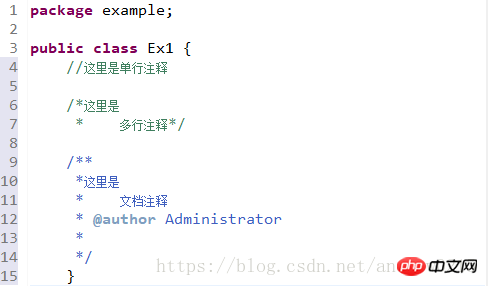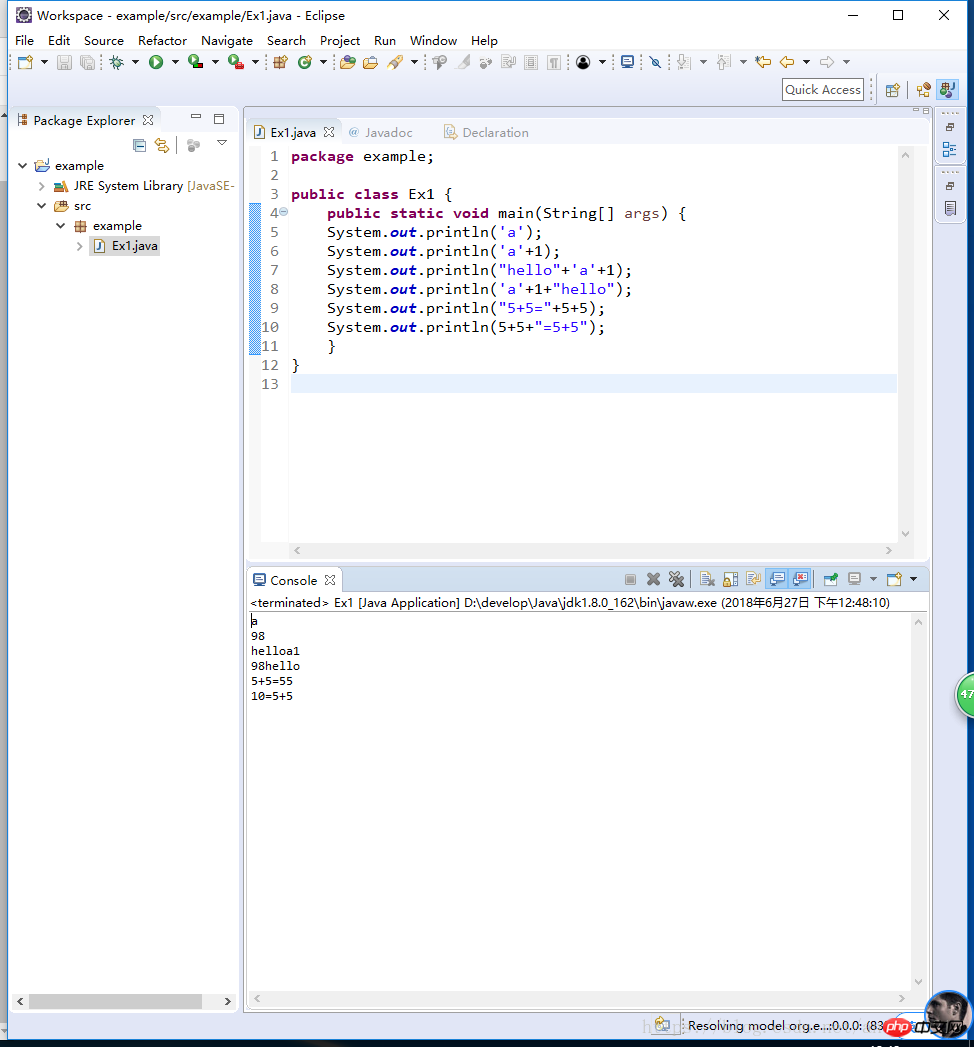JAVA introductory system tutorial (3) Basic syntax (1)
1. Keyword: a word given a specific meaning by the Java language (the letters that make up the keyword are all lowercase)
1) Use Keywords for defining data types
class, interface, byte, short, int, long, float, double, char, boolean, void## 2 ) Used to determine the data type value keyword
true, false, null
3) Used to define process control Keywords
if, else, switch, case, default, while, do, for, break, continue, return
4) Use Keywords used to define access permission modifiers
private, protected, public
5) Used to define class, function, variable modifiers Keywords
abstract, final, static, synchronized
## 6) Keywords used to define the relationship between classes
extends, implements
7) Keywords used to define the creation of instances, reference instances, and determine instances
new, this, super, instanceof
8) Keywords used for exception handling
try, catch, finally, throw , throws
9) Keywords used for packages
package、import
10 ) Other modifier keywords
native, strictfp, transient, volatile, assert
##2. Identifier: for classes, excuses, Character sequence used when naming methods, variables, etc.
(ps: must be English uppercase and lowercase letters, numeric characters, ¥ and _)
Note: It cannot start with a number; it cannot be a keyword in java; Java is strictly case-sensitive

3. Comment: Text used to describe the program
1) Single line comment: //annotation text
2) Multi-line comment: /*&*/
3) Documentation comments: /**&*/
 ##In order to have a It is a good habit for beginners to write comments first and then code when writing programs.
##In order to have a It is a good habit for beginners to write comments first and then code when writing programs.
4. Constant: Its value cannot be changed during the execution of the program
String constant Content enclosed in double quotes
Integer constants All integers Decimal constants All decimals Character constants Contents enclosed in single quotes 5. Variable: During the execution of the program, the amount that its value can change within a certain range Data type variable name = initialization value; 6. Data type: Java language is a strongly typed language. Each type of data has a clear and specific data type defined, and different sizes of memory space are allocated in the memory Precautions for using variables: Example question: System.out.println('a'); System.out.println(5 5 ”=5 5”); Observe the above output #END #Related articles: JAVA entry system tutorial (1) Configuring the JAVA development environment
##JAVA entry system tutorial (2) Installing and using eclipse
Boolean constants are more unique, only true and false
Empty constants Null (explained in the array part)
Note: The format is fixed, remember the format, and adapt to changes 

Scope: In which level of braces the variable is defined, the scope of which brace is the scope of the variable. Two variables with the same name cannot be defined in the same scope.
Initialization value: Cannot be used directly without initialization value
It is recommended to define only one variable on a line, you can define multiple, but it is not recommended
System.out.println('a' 1);
System.out.println("hello" 'a' 1 );
System.out.println('a' 1 ”hello”);
System.out.println(“5 5=" 5 5);
The above is the detailed content of JAVA introductory system tutorial (3) Basic syntax (1). For more information, please follow other related articles on the PHP Chinese website!

Hot AI Tools

Undresser.AI Undress
AI-powered app for creating realistic nude photos

AI Clothes Remover
Online AI tool for removing clothes from photos.

Undress AI Tool
Undress images for free

Clothoff.io
AI clothes remover

AI Hentai Generator
Generate AI Hentai for free.

Hot Article

Hot Tools

Notepad++7.3.1
Easy-to-use and free code editor

SublimeText3 Chinese version
Chinese version, very easy to use

Zend Studio 13.0.1
Powerful PHP integrated development environment

Dreamweaver CS6
Visual web development tools

SublimeText3 Mac version
God-level code editing software (SublimeText3)

Hot Topics
 1378
1378
 52
52
 Perfect Number in Java
Aug 30, 2024 pm 04:28 PM
Perfect Number in Java
Aug 30, 2024 pm 04:28 PM
Guide to Perfect Number in Java. Here we discuss the Definition, How to check Perfect number in Java?, examples with code implementation.
 Random Number Generator in Java
Aug 30, 2024 pm 04:27 PM
Random Number Generator in Java
Aug 30, 2024 pm 04:27 PM
Guide to Random Number Generator in Java. Here we discuss Functions in Java with examples and two different Generators with ther examples.
 Weka in Java
Aug 30, 2024 pm 04:28 PM
Weka in Java
Aug 30, 2024 pm 04:28 PM
Guide to Weka in Java. Here we discuss the Introduction, how to use weka java, the type of platform, and advantages with examples.
 Smith Number in Java
Aug 30, 2024 pm 04:28 PM
Smith Number in Java
Aug 30, 2024 pm 04:28 PM
Guide to Smith Number in Java. Here we discuss the Definition, How to check smith number in Java? example with code implementation.
 Java Spring Interview Questions
Aug 30, 2024 pm 04:29 PM
Java Spring Interview Questions
Aug 30, 2024 pm 04:29 PM
In this article, we have kept the most asked Java Spring Interview Questions with their detailed answers. So that you can crack the interview.
 Break or return from Java 8 stream forEach?
Feb 07, 2025 pm 12:09 PM
Break or return from Java 8 stream forEach?
Feb 07, 2025 pm 12:09 PM
Java 8 introduces the Stream API, providing a powerful and expressive way to process data collections. However, a common question when using Stream is: How to break or return from a forEach operation? Traditional loops allow for early interruption or return, but Stream's forEach method does not directly support this method. This article will explain the reasons and explore alternative methods for implementing premature termination in Stream processing systems. Further reading: Java Stream API improvements Understand Stream forEach The forEach method is a terminal operation that performs one operation on each element in the Stream. Its design intention is
 TimeStamp to Date in Java
Aug 30, 2024 pm 04:28 PM
TimeStamp to Date in Java
Aug 30, 2024 pm 04:28 PM
Guide to TimeStamp to Date in Java. Here we also discuss the introduction and how to convert timestamp to date in java along with examples.
 Java Program to Find the Volume of Capsule
Feb 07, 2025 am 11:37 AM
Java Program to Find the Volume of Capsule
Feb 07, 2025 am 11:37 AM
Capsules are three-dimensional geometric figures, composed of a cylinder and a hemisphere at both ends. The volume of the capsule can be calculated by adding the volume of the cylinder and the volume of the hemisphere at both ends. This tutorial will discuss how to calculate the volume of a given capsule in Java using different methods. Capsule volume formula The formula for capsule volume is as follows: Capsule volume = Cylindrical volume Volume Two hemisphere volume in, r: The radius of the hemisphere. h: The height of the cylinder (excluding the hemisphere). Example 1 enter Radius = 5 units Height = 10 units Output Volume = 1570.8 cubic units explain Calculate volume using formula: Volume = π × r2 × h (4




